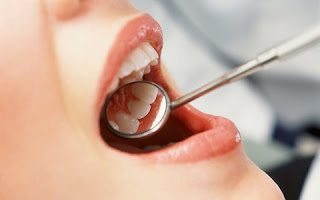Odontogenic Myxoma Definition, Symptoms, Causes, Treatment
Odontogenic myxoma is a dental condition in which the embryonic connective tissue is involved. Basically it is a tumor which is associated with the formation of tooth. Odontogenic is the word which describes the involvement of oral cavity and myxoma describes the involvement of mucous. Myxoma is a specific word which is used to describe myxoma tumor involving connective tissue. Odontogenic myxoma consist of tumor cells which are spindle shaped.
In this tumor, the collagen fibers are scattered all around and is distributed along loose mucoid material. The tumor cells of odontogenic myxoma does not have defined boundaries. These cells appear as multilocular radiolucencies. If odontogenic myxoma occurs in case of compact teeth and diagnosed in childhood then these tumor cells may appear as unilocular cysts. The septa which makes the multilocular cyst are thin and straight.
These septa forms a step ladder or tennis racket pattern. All this is observed under the light of microscope. In the diagnostic test reports, this tumor appear as a visible curved and coarse pattern. It resembles a soap bubble or honeycomb appearance. If only one or two straight septa are diagnosed during tests, then tumor is confirmed. The treatment can be started on the basis of this diagnosis.

Mostly people in between 10 and 50 years of age may develop odontogenic myxoma. Most commonly, this tumor occur in adults specifically the age range of 25 to 35 years. The mandible jaw is more affected as compare to maxilla jaw line. Odontogenic myxoma multilocular lesions occur usually at a specific site of jaw i.e. between pre molar and molar. The anterior portion of mouth usually have unilocular variety of small size. Patients experience swelling of the jaw line and there is no pain. The teeth may loosen or displacement may occur.
It is a benign tumor which may occur without any specific reason. The exact reason behind this tumor is still unknown. These are basically the dead skin cells which are not replaced by the new ones. The embryonic connective tissue is involved in the odontogenic myxoma. It may be congenital and can be diagnosed in the early childhood. It becomes severe with the passage of time. It is not an easy task to control odontogenic myxoma. It readily spread in the nearby teeth and proliferate in to them. It may also occur due to poor hygienic conditions.
There are different treatment strategies for both multilocular and unilocular lesions. For unilocular lesions, curettage and enucleation is performed after chemical bone cautery. Multilocular lesions are treated seriously and more agressively because the reoccurrence chances are high i.e. 25 percent. The tumor part is resected with a generous portion of bone surrounding it. The tumor is gelatenous in nature, so it becomes difficult to remove tumor without the chances of re-occurrence. Other than this, some medications are also prescribed to cover up the infection and inflammation. The recovery time depends on the type of odontogenic myxoma.
In this tumor, the collagen fibers are scattered all around and is distributed along loose mucoid material. The tumor cells of odontogenic myxoma does not have defined boundaries. These cells appear as multilocular radiolucencies. If odontogenic myxoma occurs in case of compact teeth and diagnosed in childhood then these tumor cells may appear as unilocular cysts. The septa which makes the multilocular cyst are thin and straight.
These septa forms a step ladder or tennis racket pattern. All this is observed under the light of microscope. In the diagnostic test reports, this tumor appear as a visible curved and coarse pattern. It resembles a soap bubble or honeycomb appearance. If only one or two straight septa are diagnosed during tests, then tumor is confirmed. The treatment can be started on the basis of this diagnosis.

Odontogenic Myxoma Symptoms
Mostly people in between 10 and 50 years of age may develop odontogenic myxoma. Most commonly, this tumor occur in adults specifically the age range of 25 to 35 years. The mandible jaw is more affected as compare to maxilla jaw line. Odontogenic myxoma multilocular lesions occur usually at a specific site of jaw i.e. between pre molar and molar. The anterior portion of mouth usually have unilocular variety of small size. Patients experience swelling of the jaw line and there is no pain. The teeth may loosen or displacement may occur.
Odontogenic Myxoma Causes
It is a benign tumor which may occur without any specific reason. The exact reason behind this tumor is still unknown. These are basically the dead skin cells which are not replaced by the new ones. The embryonic connective tissue is involved in the odontogenic myxoma. It may be congenital and can be diagnosed in the early childhood. It becomes severe with the passage of time. It is not an easy task to control odontogenic myxoma. It readily spread in the nearby teeth and proliferate in to them. It may also occur due to poor hygienic conditions.
Odontogenic Myxoma Treatment
There are different treatment strategies for both multilocular and unilocular lesions. For unilocular lesions, curettage and enucleation is performed after chemical bone cautery. Multilocular lesions are treated seriously and more agressively because the reoccurrence chances are high i.e. 25 percent. The tumor part is resected with a generous portion of bone surrounding it. The tumor is gelatenous in nature, so it becomes difficult to remove tumor without the chances of re-occurrence. Other than this, some medications are also prescribed to cover up the infection and inflammation. The recovery time depends on the type of odontogenic myxoma.
Odontogenic Myxoma Definition, Symptoms, Causes, Treatment
 Reviewed by Simon Albert
on
February 13, 2019
Rating:
Reviewed by Simon Albert
on
February 13, 2019
Rating:
 Reviewed by Simon Albert
on
February 13, 2019
Rating:
Reviewed by Simon Albert
on
February 13, 2019
Rating:











